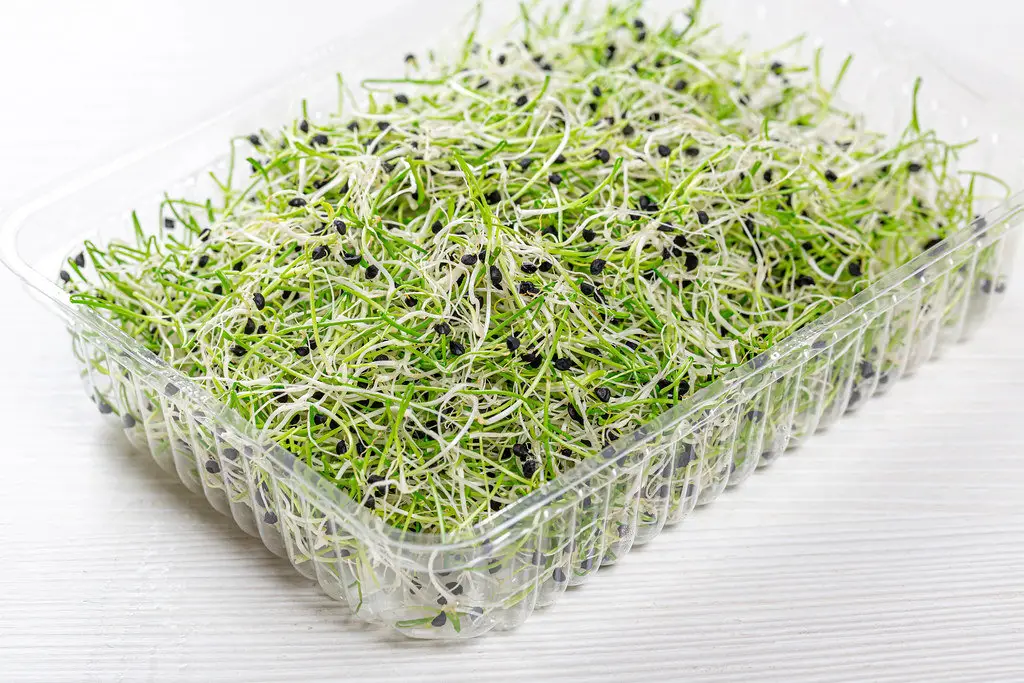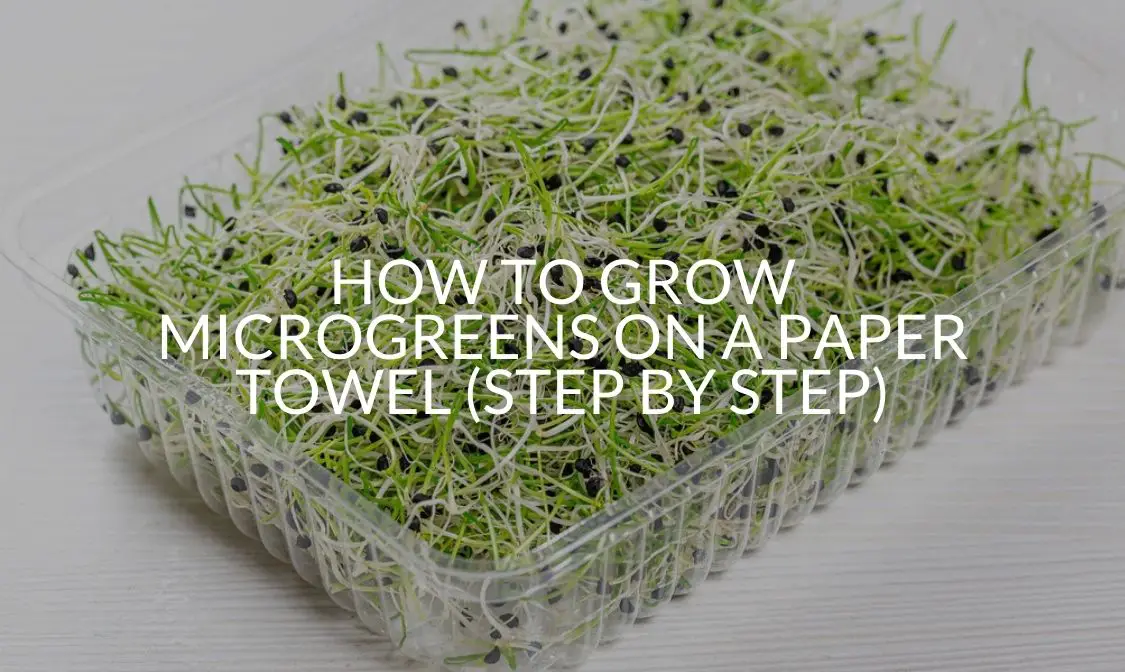Growing microgreens a popular choice for home gardeners who are health conscious.
Microgreens are relatively easy to grow and are quite cheap – you only need seeds and a few pieces of equipment to grow them.
You can grow microgreens in many mediums, but one of the easiest ways to grow them is on a paper towel. This option is really easy and much less messy than using soil in your home.
Can You Grow Microgreens On A Paper Towel?
Most often when you think of growing anything, microgreens or otherwise, you think of using soil.
But you can absolutely grow microgreens on a paper towel! Placing the seeds on a damp paper towel gives them a nice moist environment in which to grow.
Growing microgreens on a damp paper towel makes for a quick set up and clean up, and you don’t have to deal with having soil in the house – which can make a big mess.
How To Grow Microgreens On A Paper Towel
To grow your microgreens on a paper towel, you only need a few things and the process is quite simple.
The Tray
First you will need some sort of tray or container that is no deeper than 2 inches. The size of the tray doesn’t really matter, it is mostly up to your preference and what you can fit in your home.
Greenhouse growers usually use trays that are 10×20, but really any size will work, and you can do grow them in much smaller batches. You will just tailor your number of seeds to your container size.
Adding The Paper Towel
Once you have selected your container, place a layer of paper towel in your container that fits the size of the container exactly. You may have to cut your paper towel smaller or use two piece of paper towel to fit – depending on the size that you selected.
The Seeds
Once your paper towel is ready, you can lay your seeds on top of the paper.
On average, you are looking for about 21 seeds per square inch. So first figure out how many square inches your container has, and then multiply that by 21. That should give you a good idea of how many seeds you need.
Then scatter your seeds on top of the paper towel.
Using a spray bottle, spritz your seeds so that your paper towel is moist, but not so much that there are any puddles in the tray.
Light Exposure
After that, your microgreens are ready to start growing! Try to expose your seeds to 8-10 hours of sun a day. A sunny window is perfect, but if your home is usually dark then you may want to use a grow light. They can be purchased from your local garden store or from Amazon and are relatively inexpensive.
Temperature
Seeds need a relatively warm environment to sprout. The average home will be an adequate temperature, but if you keep your house cooler than about 18°C, you may want to invest in a heat mat that you can put under the seed tray.
Heat mats are specifically made to provide warm conditions for seeds to germinate. It is important to remember to remove the heat mat as soon as your seeds begin to sprout.
Harvesting
In general, microgreens are ready to harvest about 1-2 weeks after germination.
One of the benefits of growing on a paper towel is that once you are ready to harvest your microgreens, you can just pluck them right off the paper towel and eat them whole, roots and all.
If you were growing in soil, you would have to cut them off above the soil level and you wouldn’t be able to eat the root.
The hull from the seed may still be attached to the root of the microgreen. It is totally edible but if you prefer not to eat it, you can remove the hull by soaking the whole batch of microgreens in water and swishing them around with your hand. The hulls should float up to the top of the water and you can pick them out.
You can then store your microgreens in between two damp paper towels, inside a container or plastic bag, in the fridge for up to a week.
Related Articles:
- DIY Microgreen Rack Setup: Everything You Need To Know To Grow Microgreens At Home
- Why Are Microgreens So Expensive (And How Much Do They Cost?)
- Yellow Microgreens (Why It Happens & What To Do)

What Are The Benefits Of Growing Microgreens On A Paper Towel?
There are many benefits to growing your microgreens on a paper towel.
Easy Set Up And Clean Up
By using paper towel, you save the mess of having to use soil.
Because you are most likely growing microgreens in the house, you would be bringing containers of soil into your home. This can get a bit messy, and you might end up with soil on the floor or the countertop.
This can also lead to messy clean-up because most people would dump their soil after harvesting microgreens. For people who live in apartments or those without a yard, it becomes a game of “where can I put my used soil”.
The paper towel method eliminates all of that. Most of us have paper towels already in the cupboard. They are easy to store and easy to dispose of after using.
The set up for growing microgreens on a paper towel is easy – as simple as placing a piece of paper towel in a tray.
The clean-up is great too because you can toss out the old paper towel and then your tray is ready to be used again.
Edible Root
Another benefit of this method is that you are able to eat the whole microgreen, root and all.
This means that you’re getting slightly more bang for your buck when it comes to growing your microgreens. You are able to eat a little bit more of the green than if you were growing them in soil.
More Air Circulation
Many people have found that their microgreens actually grow better on paper towel than in soil.
Sometimes with soil, we may overwater or pack our microgreens in too close together in the tray, and air is not able to circulate effectively. This can lead to our microgreens rotting or just not growing well.
On the towel, we can keep the greens moist at the root, but they are also able to dry out more than in soil, reducing the risk of mold and disease.
What Are The Downsides Of Growing Microgreens On A Paper Towel?
Although there are a lot of pros, there are a couple of cons with this method.
More Work To Maintain Moisture
As mentioned above, the paper towel dries out more quickly than soil. This may mean that you have to spritz your greens more often with water.
The fact that the paper towel can dry out quickly is a good thing because it prevents rot in the roots, but also can be a disadvantage if you don’t remember to monitor your greens and water them often.
If your greens become too dry, they will wilt and fall over.
Remember to check the moisture level of the paper towel at least twice a day and to spritz them with water as necessary!
More Fragile
When you grow on paper towel, your microgreens will be a little more fragile.
In soil, they would have more to hold on to, but on paper towel they are not able to put down roots as they would in other mediums.
You will have to be very gentle when growing your microgreens on the paper towel so that you don’t damage or break them.
Related Articles:
- Do Microgreens Regrow? (Or Should You Replant?)
- Why Is There Mold On Your Microgreens? (And What To Do)
- Basil Microgreens (How To Grow, Pests, Benefits, FAQs)
FAQ
What Is The Best Way To Grow Microgreens?
All methods of growing microgreens have their pros and cons. What is most important is finding a way that works best for you and that you find to be the easiest for your home setup and lifestyle.
That being said, a great place to start is to use the paper towel as you won’t need to buy any soil, wood shavings or any other growing mediums.
What Are The Easiest Microgreens To Grow?
Some microgreens are definitely more temperamental and difficult to grow than others. Some of the easiest microgreen varieties to grow are:
- Radish
- Cabbage
- Kohlrabi
- Basil
- Broccoli
Can You Use Regular Seeds For Microgreens?
Microgreens are the tender, newly sprouted seedlings of any plant. You can absolutely use regular seeds to produce microgreens, and you don’t need to use special seeds.
In theory, you can produce microgreens from just about any seed, but obviously some are more recommended than others due to their ease of growing, taste, etc.
Final Thought
Growing microgreens is a great way to give yourself the gift of home grown nutrition. It can also be a really fun gardening project for you and your family.
Growing microgreens on a paper towel is a great way to get started with growing microgreens because you don’t need to invest in anything special other than a shallow tray.
It makes for easy clean up after you harvest your microgreens because you won’t need to deal with getting rid of your used soil or wood shavings.
Good luck on your microgreen growing journey! With a little patience, you will have fresh microgreens in no time.

